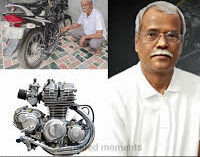After 18 years of solitary research and personal sacrifice, Shailendra Gaur says his six-stroke design could transform mobility. Experts are cautious, but his story reflects the promise—and struggle—of grassroots innovation in India.
A Workshop Dream
From a cramped rented house in Prayagraj, Shailendra Gaur has made a claim that, if true, could upend conventional automotive science. His six-stroke motorcycle engine reportedly delivers between 176 and 200 kilometers on a single litre of petrol, while also capable of running on diesel, CNG, or ethanol. Most striking of all, he asserts, the engine produces almost zero pollution.
The prototype, mounted on a 2017-model 100 cc TVS motorcycle, is already running, Gaur says. His explanation: the extra strokes improve fuel combustion, cooling, and efficiency, allowing multi-fuel flexibility with minimal emissions.
Eighteen Years, and Everything at Stake
The road to this invention has been long and punishing. Over nearly two decades, Gaur sold his land, shop, and even his home, converting his modest rented quarters into a makeshift laboratory. There, among discarded parts and tools, he pursued a vision few believed possible.
“I had no corporate lab, no investors,” he told reporters. “Only determination that India could build something unique for the world.” His perseverance has turned him into a minor social-media sensation, his story circulating widely as an example of Indian ingenuity and grit.
Recognition Without Validation
Gaur holds two patents for his engine design. But beyond the recognition of novelty, the invention has yet to undergo the rigorous independent testing and certification that would prove whether it can deliver on its extraordinary claims.
Automobile engineers, while intrigued, remain skeptical. Mileage of 176 km per litre exceeds the norms of current two-wheeler technology by a wide margin. Industry veterans insist that only controlled trials, emissions testing, and mass-scale evaluations can determine its viability.
The Next Step: From Idea to Industry
Without government backing, investor capital, or auto industry partnerships, Gaur’s innovation risks stalling in the workshop where it was born. Moving from patent to production demands not only money but regulatory approvals and industrial-scale manufacturing—hurdles that grassroots inventors rarely overcome alone.
Still, Gaur’s pursuit stands as a story larger than engineering. It illustrates the possibilities of frugal innovation in India, where resource-strapped tinkerers push the boundaries of what is technically imaginable. Whether his six-stroke engine proves revolutionary or not, Shailendra Gaur has already left his mark: showing how determination, even when isolated and underfunded, can force the world to pay attention.


